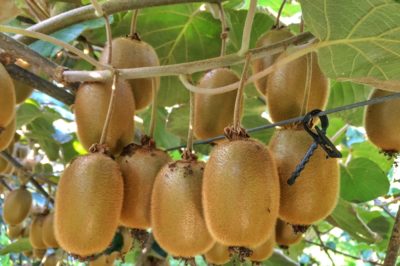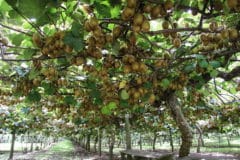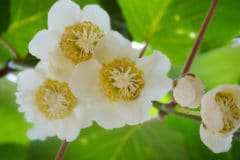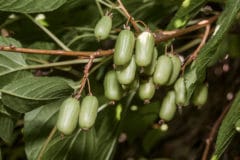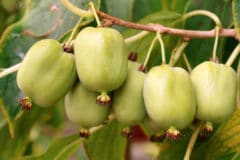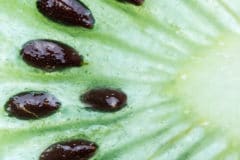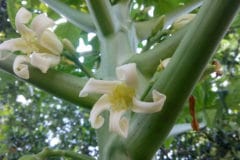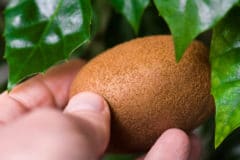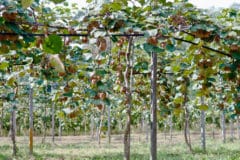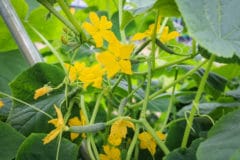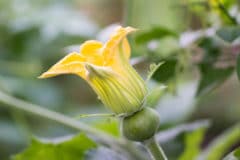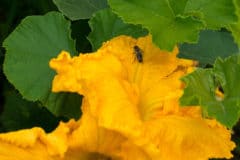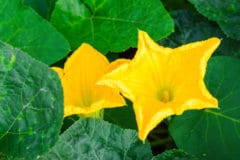What is Kiwifruit?
The kiwi, or Chinese Gooseberry, is a vine native to eastern China that produces edible fruit. Hardy kiwis originated in Russia. The plant produces both male and female vines that can easily grow 40 feet in length and must be trellised. The fragrant white flowers have a scent similar to lily of the valley. Kiwifruit is harvested in the fall. China is the world’s largest producer of kiwifruit.
Are There Different Kinds?
The Actinadia genus has around 60 different species. The basic shape is the same but they vary in color, taste and size. Among the possibilities are:
- Actinadia deliciosa – fuzzy kiwifruit
- Actinadia chinensis – golden kiwifruit
- Actinadia coriacea – Chinese egg gooseberry.
- Actinadia arguta – hardy kiwifruit
- Actinadia kolomitka – arctic kiwifruit
- Actinadia melanandra – purple kiwifruit
- Actinadia polygama – silver vine
- Actinadia purpurea – hearty red kiwifruit.
What Varieties are Available?
Actinadia chinensis and Actinadia arguta are the types most commonly grown in home gardens. Actinadia chinensis in USDA Zones 7 to 9 and varieties include:
- Hayward
- Blake
- Saanichton
Varieties of Actinadia arguta, which is hardy to Zone 3, include:
- Natasha
- Tatyana
- Ananasnaja
- Michigan State
- Ken’s Red.
How Do I Grow Kiwifruit?
If you want a kiwifruit in your garden, you’ll need plenty of space. These vigorous vines are extremely fast-growing. Not fussy about soil as long as it is slightly acidic and drains well, kiwi are often planted on raised ridges by commercial growers. Kiwifruit need full sun for good production. The plants need plenty of water because of their large leaf mass. Heavy pruning is a must due to fast growth and vine size.
Is the Kiwi a Tree?
Kiwis are vines, not trees. However, they will readily climb a tree planted in their vicinity. Like grapes, they will grow a thick trunk. With proper training and pruning, you might be able to create a tree shape from a kiwifruit vine, but it would need support and would be unlikely to produce fruit very well due to the extensive pruning needed.
How Do I Trellis Kiwifruit?
The kiwifruit is truly a huge vine, with a very heavy mass. Like a grapevine, it will take over if not kept pruned. Many gardeners use a strong wooden or metal T-shaped trellis with guy-wires. Treating kiwifruit like grapes makes good sense as their growth habits are similar. You can create a kiwifruit arbor or trellis multiple plants along wires strung between stout wooden posts.
Why Do I Need Male Plants?
Fruits are borne only on female plants and the male plant supplies the necessary pollen. There are a very few self-fruitful kiwifruits but they don’t usually produce very well. One male plant will generally pollinate up to eight female plants. Commercial growers usually plant in patterns with the females surrounding a male plant in the center.
Is There a Kiwifruit Season?
Kiwifruit need a long growing season. Most take about 240 days to break dormancy, leaf out, and produce flowers and fruit. The flowers, which appear in spring, may be susceptible to frost. Flowers grow on current season shoots that develop from the previous year’s growth. Fruit begins to reach its mature size in August but is not ready to harvest. Harvest season is late September through early December.
How Do I Prune Kiwifruit?
As noted, the kiwifruit is a rampant grower. Keep them pruned or they will take over. Prune in winter while the plant is dormant. Young canes produce the most fruit, so prune off any cane that is three years old. Make a slanting cut just above a growth node. Make sure the canopy is pruned for good sun exposure, as shade reduces flower production.
How Do I Store Kiwifruit?
Harvest fruits once they have attained maximum sweetness. You’ll have to taste to determine when this occurs. Firm fruits can be stored up to eight weeks in the refrigerator. Keep them away from other fruit such as apples, as they are sensitive to ethylene gas, which will hasten ripening. Remove from cold storage and ripen on the counter at room temperature for about a week.
